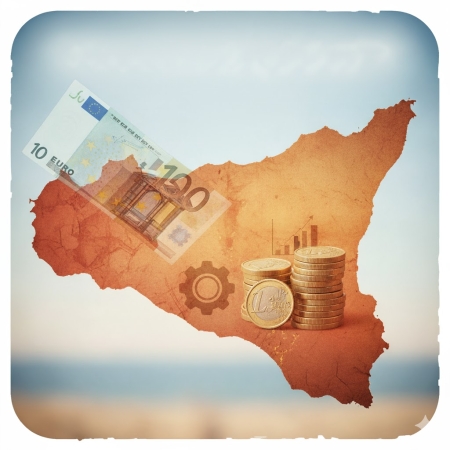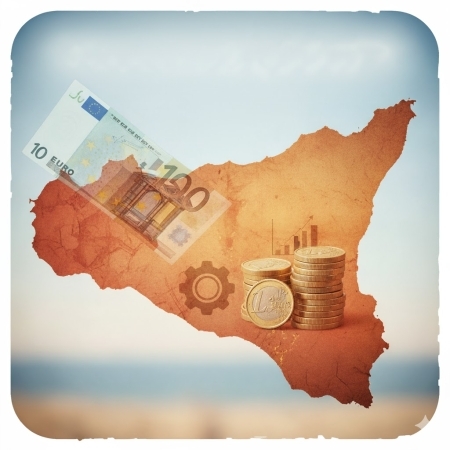Sicily continues to grow — yes — but it is a slow growth.
The latest Bank of Italy report on the Sicilian economy is a mid‑year update, produced in collaboration with bank branches, trade associations, credit institutions and other specialized bodies. And it essentially says this: Sicily’s growth rate is higher than the national average, both in GDP and employment. But it also says that the island’s economy improves slowly because some sectors (listed below) are struggling to keep pace.
Here are the five key points behind the numbers — to truly understand how Sicily’s economy is performing in 2025.
1. Sicily’s economy is growing, but losing momentum
In the first six months of 2025, regional GDP increased by 1.1% compared to the same period the previous year. According to the Bank of Italy, this is higher than both the Southern Italy average and even the national average. In other words, Sicily is one of the few Italian regions that is actually growing.
Businesses remain solid: around 9 out of 10 companies expect to close 2025 with a profit. As a result, business liquidity has reached historic highs — peaking at around €22 billion in June 2025.
Meanwhile, Sicilians are spending more, encouraged by rising household income and slowly increasing consumer confidence. Family income grew by 2.1% (again, above the national average), and daily spending increased by 1.1%, indicating that the economy is moving — even if slowly.
However, despite these positive signals, Sicily’s economic recovery is losing speed. Key sectors — including oil refining, private construction, salaried employment and domestic tourism — show signs of stagnation, ultimately slowing overall growth.
2. The collapse of oil exports is dragging down Sicilian trade
Sicily’s exports have plummeted: –11.2% year‑on‑year.
The main reason is oil. In the first half of 2025, the island’s petroleum export sector collapsed by 28%, and now accounts for less than half of all regional exports.
Other export sectors, however, are performing well. Non‑oil exports grew by 15.2%, driven by electronics, shipbuilding and agri‑food products. Sicily is increasingly exporting technology and agricultural goods, while oil becomes less central.
Trade with non‑EU countries — especially the United States — is suffering. Sicilian exports to the US dropped by more than 50%, though the Bank of Italy sees this as temporary: American importers had stockpiled goods ahead of expected tariff increases in the second half of the year.
Sicilian exporting companies remain optimistic: one in two expects to offset U.S. losses with sales in other markets.
3. In construction, public works lead the way
The construction sector remains strong overall — but uneven.
Public works are the main engine, boosted by municipal investments and especially by PNRR (EU Recovery Plan) funds. According to the Bank of Italy, one in two construction firms has increased orders thanks to publicly funded projects.
Public projects and urban regeneration have kept demand high, partially offsetting the slowdown in other areas.
Private construction, however, is weakening. Hours worked fell compared to 2024 due to the phasing out or reduction of renovation and energy‑efficiency tax incentives, which had driven an exceptional boom the previous year.
Overall, construction remains a pillar of Sicily’s economy — but increasingly reliant on public investment to keep worksites active.
4. More employment, but unemployment remains extremely high
Employment in Sicily increased by 2.9%, outpacing the national average.
Yet the reality is more complex.
Most of the growth comes from self‑employment, which compensated for the slowdown in salaried work, especially in services and tourism.
According to INPS data, private‑sector hiring (about 68,000 contracts) remained stable year‑on‑year, but contract types changed significantly:
Fixed‑term hires: –1.8%Apprenticeships: –6.9%Agency work: –3.6%
Seasonal employment is declining, particularly in sectors like private construction and tourism, which until 2024 had been key drivers of Sicilian job creation.
Unemployment, however, remains extremely high at 13.7% — double the national average (6.7%).
5. Fewer Italian tourists — and hotels are empty
After a booming 2024, tourism slowed in early 2025.
Overnight stays dropped by 4% statewide, ending the positive trend that saw +5.5% growth in 2024.
The sharpest decline concerns Italian visitors: –8.7% in the first half of 2025.
Foreign tourism remains stable.
The decline is worst in Trapani and Ragusa, while Palermo and Syracuse saw a slight increase.
Transport numbers, however, remain positive:
Port traffic: +7.1%, thanks to the cruise boomAir travel: +0.5%, with more international flights compensating for fewer domestic ones
A notable trend: tourists now prefer non‑hotel accommodations (vacation rentals and B&Bs), while traditional hotels lose market share.
This shift signals a tourism sector that is not collapsing, but changing — fewer long holidays, more short stays, and new hospitality models reshaping the wider economy.

